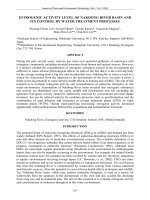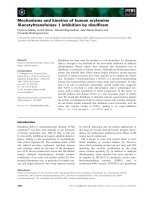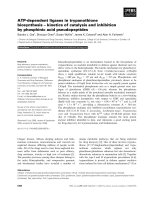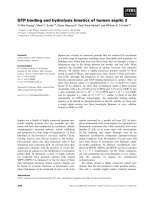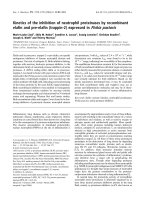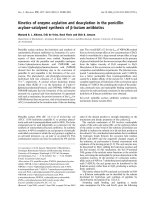Kinetics of oxidation of toluidine blue by periodate: Catalysis by water pools of CTAB
Bạn đang xem bản rút gọn của tài liệu. Xem và tải ngay bản đầy đủ của tài liệu tại đây (345.19 KB, 8 trang )
Current Chemistry Letters 7 (2018) 93–100
Contents lists available at GrowingScience
Current Chemistry Letters
homepage: www.GrowingScience.com
Kinetics of oxidation of toluidine blue by periodate: Catalysis by water pools of
CTAB
K.V. Nagalakshmia*, P. Shyamalab and P.V. Subba Raoc
a
Department of Chemistry, G.V.P.College of Engineering (Autonomous), Madhurawada, Visakhapatnam-530048, India
Department of Physical chemistry, Andhra University, Visakhapatnam-530017, India
Retired Professor, Department of Physical chemistry, Andhra University, Visakhapatnam-530017, India
b
c
CHRONICLE
Article history:
Received June 28, 2018
Received in revised form
July 20, 2018
Accepted August 20, 2018
Available online
August 20, 2018
Keywords:
Kinetics
Oxidation
Toluidine blue
Periodate
Water pools
ABSTRACT
Kinetic study of oxidation of toluidine blue (TB+) by periodate was carried out in aqueous
medium and also in the cetyl trimethyl ammonium bromide (CTAB) reverse micellar medium.
In both the media reaction obeys first order kinetics with respect to each of the reactants. In the
reverse micellar medium, the reaction is forty times faster compared to aqueous medium under
identical experimental conditions. The pronounced acceleration is accounted for by the lower
micro polarity and the concentration effect present in the bound water of reverse micelles. In
CTAB reverse micellar medium, the pseudo first order rate constant (k’) of the reaction is
almost constant at all values of W, {W=[H2O]/[CTAB]} indicating that the reaction takes place
on the micellar surface and results were explained by modified Berezin pseudo phase model.
© 2018 Growing Science Ltd. All rights reserved.
1. Introduction
The solubilised water present in the polar cavity of reverse micelles is called water pool which has
unique properties like lower dielectric constant i.e. micropolarity, higher viscosity, lower
thermodynamic activity of water, higher ionic strength (in the case of reverse micelles made of ionic
surfactants) and altered nucleophilicity compared to water in the conventional aqueous media 1-5. These
anomalous properties of the water pool are dependent on a W parameter, W = ([H2O] / [Surfactant])
and as the value of W increases the properties approach that of ordinary water. These physical properties
of water are known to alter rates and even mechanism of the reactions 6-8. In addition to these properties,
there is concentration effect as the reactants are constrained in the small fraction of the water pool
which also affects rates of reactions. We have earlier reported kinetics of dissociation of [Fe(tptz)2]2+
in the presence of CTAB reverse micelles and have found that low dielectric constant of the water pool
facilitates the formation of ion pair between complex and bromide ion of CTAB9. In another reaction,
kinetics of oxidation of iodide by Vanadium (V) in CTAB reverse micelles, we found that concentration
effect present in the water pool predominates over ionic strength and dielectric constant.10
* Corresponding author. Tel.: +891-9000900913
E-mail address: (K.V. Nagalakshmi)
2018 Growing Science Ltd.
doi: 10.5267/j.ccl.2018.08.004
94
Toluidine blue (3-amino-7-dimethyl-amino-2-methyl phenazathinium chloride) a phenothiazine
dye, is generally used as biological sensitizer, polymerization inhibitor and complexing agent. Since
the toluidine blue dye has both biological and industrial applications, micellar catalysed redox reactions
of toluidine blue is therefore important and hence we have selected the oxidation of toluidine blue for
studying the effect of CTAB/Hexane/Chloroform reverse micelles.
2. Results and Discussion
The kinetics of the reaction has been investigated in the aqueous medium and in CTAB reverse
micelles under pseudo first order conditions, {[IO4-] >> [TB+]} varying the concentration of periodate
in the range 0.6×10-4 to 60.0 ×10-4 mol dm-3 and keeping the concentration of TB+ at 1.2 ×10-5 mol dm3
thus isolating TB+.
Fig. 1. Plots of log (At) versus time
Fig. 2. Plots of k' versus [IO4-]
In CTAB reverse micellar medium, reaction obeys first order kinetics with respect to [TB+] as
shown by linear plots between log (absorbance) versus time. (Fig.1). A plot of pseudo first order rate
constant, k' versus [IO4-] was found to be linear passing through origin indicating first order kinetics
with respect to IO4- (Fig.2). The reaction has also been carried out in aqueous medium under identical
conditions. Similar kinetic features were observed in aqueous medium also and are given in Table 1.
Table 1. Pseudo first order rate constants in aqueous medium at T = 304 ± 0.1
[TB+] ×105
(mol dm-3)
1.2
2.5
4.0
6.5
1.2
1.2
1.2
1.2
1.2
1.2
1.2
1.2
1.2
1.2
[IO4-] ×103
(mol dm-3)
2.4
2.4
2.4
2.4
1.2
2.4
6.0
12
24
2.4
2.4
2.4
2.4
2.4
µ
(mol dm-3)
1.0
1.0
1.0
1.0
1.0
1.0
1.0
1.0
1.0
0.5
1.0
2.77
3.33
4.16
k'×105
(sec-1)
6.61
6.62
6.61
6.61
3.38
6.61
16.5
34.2
66.1
12.5
6.61
3.04
2.95
1.89
To compare the rate constants of the reaction in the presence of reverse micelles and in aqueous
medium, kinetic runs were carried out keeping the concentrations of reactants and ionic strengths same
in the both the media. The calculation of ionic strength (μ) in the water pool (i.e. by considering the
K.V. Nagalakshmi et al. / Current Chemistry Letters 7 (2018)
95
concentration of bromide ion of CTAB) has been carried out using the method adopted by Munoz et al
11
. The data are presented in the Table 2.
Table 2. Comparison of rate constants in the aqueous medium and in the presence of
0.1 mol dm-3 CTAB at same ionic strength (µ)
[TB+]= 1.2×10-5 mol dm-3; [IO4-] = 2.4×10-3 mol dm-3; T = 304 ± 0.1 K
[Br-]e
k'aq.med×105
k'rev mic×104
(mol dm-3)
(sec-1)
(sec-1)
2.77
3.04
7.51
3.33
2.95
7.48
4.16
1.89
7.45
It can be seen that at the same ionic strength and reactant concentrations, the pseudo first order rate
constant is about forty times more in the presence of reverse micelle compared to the aqueous medium
at μ=4.16 mol dm-3. The same rate constant is around twenty times in the reverse micelle at an ionic
strength of 2.77 mol dm-3. The large acceleration in the reverse micelle is due to two reasons; one is
concentration effect as the reactants are constrained in the small fraction of the water pool and other is
low dielectric constant of the water pool which facilitates the reaction between the two oppositely
charged ions.
Effect of W and [CTAB]
The reaction has been carried out at different W values keeping the concentration of CTAB at 0.1
mol dm-3. The study has been repeated at 0.2 mol dm-3 and 0.3 mol dm-3 CTAB concentrations. The
results are given in the Table 3.
Table 3. Effect of variation of W and [CTAB]
[TB+]= 1.2×10-5 mol dm-3; [IO4-] = 2.4×10-3; T = 304 ± 0.1 K
[CTAB]
(mol dm-3)
0.1
0.2
0.3
[Br-]e
16.6
12.5
8.33
6.25
4.16
3.33
2.77
16.6
12.5
8.33
6.25
4.16
3.33
2.77
16.6
12.5
8.33
6.25
4.16
3.33
2.77
103×f
(volume fraction)
6.00
8.00
12.0
16.0
24.0
30.0
36.0
12.0
16.0
24.0
32.0
48.0
60.0
72.0
18.0
24.0
36.0
48.0
72.0
90.0
108
W
3.33
4.44
6.66
8.88
13.3
16.6
20.0
3.33
4.44
6.66
8.88
13.3
16.6
20.0
3.33
4.44
6.66
8.88
13.3
16.6
20.0
k '×104
(sec-1)
7.12
7.26
7.14
7.26
7.45
7.48
7.51
4.21
4.35
4.40
4.73
4.85
4.97
5.01
3.15
3.26
3.29
3.95
3.56
3.71
3.78
96
The pseudo first order rate constant k' is almost constant with increase in W at constant [CTAB].
This constancy indicates that the reaction takes place on the micellar surface. When reaction takes place
in water pool of reverse micelles, the rate constant would change with W. Periodate is a hydrophilic
species carrying negative charge, insoluble in hexane and chloroform and can be expected to be found
between the aqueous water pool and the interface. The binding constant of periodate from
spectrophotometric studies was found to be around 20 mol-1 dm3. Toluidine blue can be incorporated
into the cationic micelle by hydrophobic attractions. These hydrophobic attractions are sufficiently
strong to overcome the electrostatic repulsions between the dye molecules and micelles of similar
charge. This is indicated by the high binding constant, 1.5×102 mol-1 dm3 obtained for TB+ in the
presence of CTAB reverse micelles at W=3.33 (Table 4).
Table 4. Binding constants in CTAB reverse micellar medium
From spectrophotometric method
Binding constant of
Binding constant of
periodate)
W
Toluidine blue (mol-1 dm3)
(mol-1 dm3)
3.33
1.53×102
22.5
6.66
1.26×102
20.2
16.6
0.99×102
16.9
From kinetics
(Toluidine blue vs
periodate)
(mol-1 dm3)
23.9
19.3
14.1
There entire reaction take place at interface. To explain the experimental results obtained in the kinetic
study of the reaction between TB+ and IO4-, the reaction scheme1 has been considered,
k'
(TB+)i + (IO4 -)i
Products
(IO4 -)w
Scheme 1
where ‘i’ represents micellar interface and ‘w’ represents water pool of reverse micelles. The following
mass balance equations developed by Berezin 12,13 can be used to calculate the concentration of TB+
and IO4- in the micellar phase,
(1)
[TB+ ]M
pTB+ =
.
+
[TB ]W
where pTB+ is the distribution coefficient of TB+ .
(2)
[TB+ ]M
.
[TB+ ]W =
pTB+
+
If [TB ]o is the total concentration of TB+ then, [TB+ ]o =[TB+ ]W +[TB+ ]M and
(3)
[TB+ ]o =[TB+ ]W (1-CV)+[TB+ ]M CV,
where C is the concentration of the micelle and V is the molar volume.
From Eq. (2) and Eq. (3)
[TB+ ]o =
[TB+ ]M (1-CV)
+ [TB+ ]M CV.
pTB+
(4)
Neglecting CV in comparison to 1,
[TB+ ]o = [TB+ ]M CV +
1
pTB+
; [TB+ ]M =
[TB+ ]o pTB+
.
pTB+ CV + 1
K.V. Nagalakshmi et al. / Current Chemistry Letters 7 (2018)
[TB+ ]o pTB+
(KTB+ C+1)
= pTB+ V , SinceKTB+ = 1.53×102;
97
(5)
Hence,[TB+ ]M =
KTB+
[TB+ ]o pTB+
Therefore, [TB+ ]M =
Similarly,
[IO-4 ]
M
=
KTB+ C
[IO-4 ] pIOo
1+KIO-4 C
According to Berezin model,
4
1+KTB+ C ~ KTB+ C.
(6)
.
(7)
.
(8)
rate = kM [TB+ ]M [IO-4 ] CV+ kW [TB+ ]W [IO-4 ] (1-CV).
M
W
Since the reaction is much faster in the presence of CTAB reverse micelles, kW can be neglected.
rate = kM [TB+ ]M [IO-4 ] CV
M
From Eq. (6) and Eq. (7),
[TB+ ]o pTB+ [IO4 ]o pIO-4 CV
rate = kM
,
KTB+ C
(1+KIO- C)
4
kM pTB+ pIO- CV
4
k' =
,
KTB+ C (1 + KIO-4 C)
kM pIO4
,
k' =
(1+KIO-4 C)
KIO-4 C
1
1
=
+
.
k' kM pIOkM pIO4
(9)
(10)
4
According to Eq. (10), the plot of 1/ k' versus concentration of CTAB (C) was found to be a straight
line (Fig.3) and from the slope and intercept the binding constant of periodate was determined at
different W values. The binding constants obtained from the plots are in good agreement with the values
measured from spectrophotometry (Table 4).
Fig. 3. Plots of 1/k' versus [CTAB]
Fig. 4. IR spectrum of the product
98
3. Conclusions
When investigating the kinetics of oxidation of Toluidine
CTAB/Hexane/Chloroform reverse micelles, it was found that:
blue
by
Periodate
in
1. The reaction has been found to be accelerated around forty times in the presence of CTAB reverse
micelles. Significant increase of rate in the CTAB reverse micellar medium is due low micro polarity
of bound water of reverse micelles which facilitates the reaction between two oppositely charged ions.
2. The pseudo first order rate constant (k') of the reaction is almost constant at all values of W, indicating
that the reaction entirely takes place on the micellar interface. When reaction takes place in water pool
of reverse micelles, the rate constant would change with W.
3. The plots of pseudo first order rate constant (k') versus concentration of CTAB were linear and
binding constants obtained from these plots are in good agreement with the values measured from
spectrophotometry. The linearity shows the validity of Berezin pseudo phase model for this reaction in
reverse micellar medium.
Acknowledgements
We (KVNL and PS) thank UGC, India under the minor research project MRP-4552(14)
(SERO/UGC) and DST, India under the project SERB/F/5725/2013-14 respectively for financial
support.
4. Experimental
4.1. Materials
Stock solutions of toluidine blue (Sigma, India) and sodium periodate (Merck, India) were prepared
in triple distilled water. Chloroform and hexane were double distilled before use. CTAB (Cetyl tri
methyl ammonium bromide) purchased from Sigma was used without further purification. Reverse
micellar solutions of CTAB (0.1 mol dm-3 , 0.2 mol dm-3 and 0.3 mol dm-3 ) were prepared by dissolving
requisite amounts of CTAB in chloroform-hexane (3:2 v/v) mixtures.
4.2. Preparation of reverse micellar medium and initiation of the reaction
0.04 ml of periodate solution (0.6 mol dm-3) was injected into 10 ml of 0.1 mol dm-3 CTAB solution
using a micro pipette. 0.02 ml of toluidine blue solution (0.006 mol dm-3) was then added to begin the
reaction. The reaction mixtures were shaken vigorously to obtain a transparent and homogenous
solution that can be regarded as a reverse micellar system. The molar ratio of [Water] to [CTAB] i.e.
W was varied in the range 3.33 to 20.0.
4.3. Determination of Binding Constants
The binding constants of toluidine blue and periodate were determined in
CTAB/Hexane/Chloroform reverse micelles at W=3.33, W=6.66 and W=16.6. The absorbance of
toluidine blue (at λ = 626 nm) and periodate (at λ = 260 nm) has been recorded for different
concentrations of CTAB. The binding constant (K) has been determined 14, 15 from the plot of
versus 1/C using the Eq. (11),
1
1
1
,
o =
o
o +
o
AM -AW
AM -AW
AM -AoW KC
1
AM -AoW
(11)
K.V. Nagalakshmi et al. / Current Chemistry Letters 7 (2018)
99
where, AM is the absorbance in reverse micelles; AoW ,the absorbance in water, AoM is the limiting
absorbance in reverse micelles and C, the concentration of reverse micellar solution.
4.4. Kinetic measurement
The kinetics of the reaction was monitored by measuring the decrease in absorbance of toluidine
blue at a wave length of 626 nm (Ɛ626 = 29,800 mol-1cm-1) using a SHIMADZU double beam
spectrophotometer. The reaction was carried out under pseudo first order condition, [IO4-] >> [TB+] at
304±0.1 K. The pseudo first order rate constants were obtained from slopes of log (absorbance, At)
versus time. The experimental data are the averages from duplicate runs with reproducibility less than
±4%.
4.5. Product analysis
TB+ (1.2×10-5 mol dm-3) and periodate (2.4 ×10-3 mol dm-3) were mixed to make 500 ml solution.
After 24 hours, the organic components were extracted into diethyl ether and subjected for Infrared
analysis. The Infrared spectrum of the product showed a sharp band at 1005-1070 cm-1, suggesting the
formation of sulfoxide. No intense peaks indicative of sulfones in the region of 1300-1135 cm-1 were
observed which excludes the formation of sulfone. The strong peaks in the ranges of 3000-3300 cm-1
and 2700-3000 cm-1 indicated the presence of intact primary and secondary amino groups on the
aromatic heterocyclic ring. (Fig.4). From stoichiometry and product analysis the overall reaction is
given in scheme 2.
H3 C
H2 N
N
S
H3 C
+ 3IO4
+
N(CH3)2
N
-
+2
H2 N
S
HCHO+ 3IO3-
NH2+
O
Scheme 2
References
1. Menger F. M., Donohue J. A., and Williams R. F. (1973) Catalysis in water pools. J. Am.
Chem. Soc., 95(1) 286-288.
2. Goto A., and Kishimoto H. (1989) The Addition of the Cyanide Ion to the N-Methyl-3carbamoylpyridinium Ion in Reversed Micelles. Bull. Chem. Soc. Jpn, 62 2854-2861.
3. Sunamoto J., Hamada T. (1978) Solvochromism and Thermochromism of Cobalt(II)
Complexes Solubilized in Reversed Micelles. Bull. Chem. Soc. Jpn, 51, 3130-3135.
4. Bridge N. J., and Fletcher P. D. I. (1983) Time-resolved studies of fluorescence quenching in
a water-in-oil microemulsion. J. Chem. Soc. Faraday Trans., 79(9) 2161-2169.
6. Harasit K. M., Majumdar T., and Ambikesh M. (2011) Kinetics of basic hydrolysis of
tris(1,10-phenanthroline)iron(II) in macromolecular assemblies of CTAB
Int. J .Chem. Kinet, 43(10) 579-589.
7. Johnson M.D., Lorenz B.B., Wilkins P.C., Lemons B.G., Baruah B., Lamborn N., Stahla M.,
Chatterjee P.B., Richens D.T., and Crans D.C. (2012) Switching Off Electron Transfer
Reactions in Confined Media: Reduction of [Co(dipic)2]− and [Co(edta)]− by
Hexacyanoferrate(II). Inorg. Chem., 51(5) 2757-2765.
8. Jamil K. J. S. (2006) Kinetics of the Oxidation of Phenylhydrazine by [Fe(CN)6]3− in Water‐
in‐Oil Microemulsion. J. Dispersion. Sci. Technol, 27(6) 795-798.
100
9. Nagalakshmi K.V., padma M., Srikanth V., Shyamala P., and Subba Rao P.V. (2013)
Catalytic effect of CTAB reverse micelles on the kinetics of dissociation of bis(2,4,6tripyridyl-s-triazine) iron(II). Transition Met Chem, 38 523-527.
10. Shyamala P., and Subba Rao P.V. (2010) Kinetics of Oxidation of Iodide by Vanadium
(V):Catalysis by the Water Pools of CTAB Reverse Micelles. Kinet. Catal, 51(2) 207-210.
11. Munoz E., Gomez – Herrera C., Garciani M., Moya M L., and Sanchez F. (1991) Kinetics
of the oxidation of iodide by persulphate in AOT–oil–water microemulsions .J Chem Soc,
Faraday Trans, 87(1) 129-132.
12. Silber J. J., Biasutti A., Abunin E. (1999) Interactions of small molecules with reverse
micelles. Adv in Colloid and Interface Sci., 82(1) 189-252.
13. Fletcher P.D.I., Robinson B.H. (1984) Effect of organized surfactant systems on the kinetics
of metal–ligand complex formation and dissociation. J. Chem. Soc. Faraday Trans., 80(1)
2417-2437.
14. Sepulveda L. (1974) Absorbances of solutions of cationic micelles and organic anions.J
Colloid Interface Sci, 46(3) 372-379.
15. Srikanth V., Shyamala P., Satyanarayana A., and Subba Rao P.V. (2012) Alkaline hydrolysis
of isatin in the presence of mixed CTAB and Triton X-100 micellar systems: Micellisation
and kinetic investigations. Indian J. of Chem., 51(A) 1701-1705.
© 2018 by the authors; licensee Growing Science, Canada. This is an open access
article distributed under the terms and conditions of the Creative Commons Attribution
(CC-BY) license ( />
